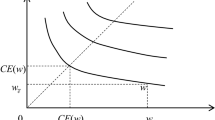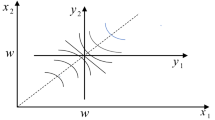Abstract
Standard principles of rational decision assume that an option’s utility is both comprehensive and accessible. These features constrain interpretations of an option’s utility. This essay presents a way of understanding utility and laws of utility. It explains the relation between an option’s utility and its outcome’s utility and argues that an option’s utility is relative to a specification of the option. Utility’s relativity explains how a decision problem’s framing affects an option’s utility and its rationality even for an agent who is cognitively perfect and lacks only empirical information. The essay rewrites standard laws of utility to accommodate relativization to propositions’ specifications. The new laws are generalizations of the standard laws and yield them as special cases.
Similar content being viewed by others
References
Bacharach, M. (2006). Beyond individual choice: Teams and frames in game theory (N. Gold & R. Sugden, Eds.). Princeton, NJ: Princeton University Press.
Chalmers D. (2002) The components of content. In: Chalmers D. (eds) Philosophy of mind: Classical and contemporary readings. Oxford University Press, New York, pp 608–633
Crimmins M. (1992) Talk about beliefs. MIT Press, Cambridge, MA
Dacey R., Zielonka P. (2008) A detailed prospect theory explanation of the disposition effect. Journal of Behavioral Finance 9(1): 43–50
Fox C.R., Tversky A. (1995) Ambiguity aversion and comparative ignorance. The Quarterly Journal of Economics 110(3): 585–603
Horgan T. (2000) The two-envelope paradox, nonstandard expected utility, and the intensionality of probability. Noûs 34: 578–602
Kahneman D., Tversky A. (1979) Prospect theory. Econometrica 47: 263–291
Kahneman D., Tversky A. (1982) The psychology of preferences. Scientific American 246: 160–173
Lerner J.S., Keltner D. (2000) Beyond valence: Toward a model of emotion-specific influences on judgement and choice. Cognition and Emotion 14(4): 473–493
Lerner J.S., Keltner D. (2001) Fear, anger, and risk. Journal of Personality and Social Psychology 81(1): 146–159
Lewis, D. (1983). Attitudes De Dicto and De Se. In D. Lewis (Ed.), Philosophical papers (Vol. I, pp. 133–159). New York: Oxford University Press.
Peterson M. (2003) Transformative decision rules: Foundations and applications. Theses in philosophy from the Royal Institute of Technology. The Royal Institute of Technology, Stockholm
Resnik M. (1987) Choices. University of Minnesota Press, Minneapolis
Rubinstein A. (1998) Modeling bounded rationality. MIT Press, Cambridge, MA
Savage L. (1954) The foundations of statistics. Wiley, New York
Schick F. (2003) Ambiguity and logic. Cambridge University Press, Cambridge
Sobel J.H. (1994) Taking chances: Essays on rational choice. Cambridge University Press, Cambridge
Tversky A., Kahneman D. (1986) Rational choice and the framing of decisions. The Journal of Business 59(4, 2): S251–S278
Tversky A., Simonson I. (1993) Context-dependent preferences. Management Science 39(10): 1179–1189
van Fraassen B. (2002) The empirical stance. Yale University Press, New Haven, CT
Weirich P. (2001) Decision space: Multidimensional utility analysis. Cambridge University Press, Cambridge
Weirich P. (2004) Realistic decision theory: Rules for nonideal agents in nonideal circumstances. Oxford University Press, New York
Weirich, P. (forthcoming). Probabilities in decision rules. In E. Eells & J. Fetzer (Eds.), The place of probability in science. Chicago: Open Court.
Williamson T. (2007) Philosophy as philosophy. Blackwell, Malden, MA
Author information
Authors and Affiliations
Corresponding author
Rights and permissions
About this article
Cite this article
Weirich, P. Utility and framing. Synthese 176, 83–103 (2010). https://doi.org/10.1007/s11229-009-9485-0
Received:
Accepted:
Published:
Issue Date:
DOI: https://doi.org/10.1007/s11229-009-9485-0




